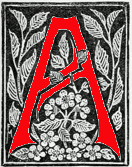This is an extract from "Some Noted Women Painters," an article in the Magazine of Art of 1895. It has been formatted (with extra paragraph breaks) and illustrated by Jacqueline Banerjee, with thanks to Shirley Nicholson, who first came across it. Click on the images for more information about them, and to see larger versions of them.

native of Austria, Mrs. Marianne Stokes has, by marriage and by the establishment of her home in England, almost anglicised herself. Ever since she can remember she wanted to become a painter, a desire which at one time did not seem likely to be realised, for in her birthplace few, if any, painters lived. For five years, however, she studied at Munich, and while there gained a recompense the existence of which had a quaint origin. Nearly a century before Mrs. Stokes commenced her artistic education, a poor drawing-master died in Styria, leaving his savings, amounting to only a few gulden, to accumulate, and to be offered as a prize at the end of a hundred years to the most promising Styrian art-student. Mrs. Stokes, then studying in Munich, was the successful competitor, gaining the prize with her first picture, Mutter-glück.

Drawing of herself, by Stokes, accompanying the article (p.19).
From Munich Mrs. Stokes went to Paris, where she studied under Dagnan-Bouveret, Courtois, and Colin. Her first Salon picture was painted in Brittany, in 1884, and was called Reflection. The second gained a Mention Honorable, and the next year (1885) it was exhibited at the Royal Academy. The same year it was shown at Liverpool, and there it found its final resting-place, being purchased by the Trustees for the Permanent Collection. Madonna, Light of Life, by which Mrs. Stokes was represented at the last Grosvenor Exhibition, has again been seen in London this year at the Guildhall Loan Exhibition, to which it was most unwillingly sent by its owner — a lady living in Munich. To the same Guildhall Exhibition, Mr. McCulloch, the great Australian collector, also lent Mrs. Stokes’ charming little Goatherd of the Tyrol, shown at the Institute in 1892, by many of the critics considered one of the most perfect pictures at that exhibition.
Angels Entertaining the Holy Child, which was in last year’s Academy, is now in Vienna, as well as the Hail Mary, exhibited at Burlington House in 1890, and which has in the meantime visited Chicago, where it gained a medal in the British section. To Chicago also went the pathetic picture, Go, Thou Must Play Alone, my Boy, which gained for its painter a gold medal in Munich in 1891, and which is now included in an important private collection in America. Edelweiss is not well known in England, for it has only once been exhibited publicly, and then was purchased by the Prince Regent of Bavaria.
Pont-Aven is full of pleasant recollections to Mrs. Stokes, for it was not only there that she painted her first Salon picture, but it was there also that she met Mr. Adrian Stokes [1854-1935], the able painter to whom she was married in 1884. Since their marriage, Mr. and Mrs. Stokes have travelled a great deal, as the various scenes of their pictures have shown; but for the last six years they have lived and painted principally at St. Ives — whence, however, Mrs. Stokes flies away occasionally to pay a visit to her beloved Tyrol.

When they were not in Cornwall, the Stokeses lived at No 6 The Studios, Edwardes Square, Kensington, with its six big north facing windows (photo and caption by Shirley Nicholson).
Note
Naturally, many details are missing from this short account, which only covers the earlier part of Stokes's life. It makes no mention of the fact that she was a committed Catholic (hence her many paintings on religious themes); the association of her work with that of the Newlyn School; and the inspiration she took from Grimms' fairy tales, for example in The Frog Prince (1894), as well as various medieval and romantic subjects — an expression of her Pre-Raphaelite sympathies. Among the significant events that occurred after 1895 were the couple's joint exhibition at the Fine Art Society in London, in 1900: "Dutch Life and Landscape."
Later developments include: Stokes's becoming a founding member of the Society of Painters in Tempera, from 1905, and her membership of the Artists' Suffrage League, which led to her designing banners for the suffrage procession held in 1908. A very beautiful tapestry that she designed for Morris & Company in 1912, shortly before the Merton Abbey works stopped making them, was widely exhibited and admired: it was inspired by Schiller's "Ehret Die Frauen" ("Honour the Women"), and is now in the Whitworth Art Gallery, Manchester. Although the couple spent much of their time together in Europe, they kept their old ties with Cornwall: both showed work at the St Ives Society of Artists in 1927, the very year of her death in London, on 13 August. She had considerable success and many of her works are in public collections. — JB
Bibliography
"Marianne Stokes Artist." Ben Uri Research Unit. Web. 4 June 2023.
Postlethwaite, Hélène L "Some Noted Women Painters." The Magazine of Art 18 (1895): 17-22. Internet Archive. Sponsored by the Kahle/Austin Foundation. Web. 4 June 2023.
Yeldham, Charlotte. "Stokes [née Preindlsberger], Marianne (1855–1927), artist." Oxford Dictionary of National Biography. Online ed. Web. 4 June 2023.
Created 4 June 2023